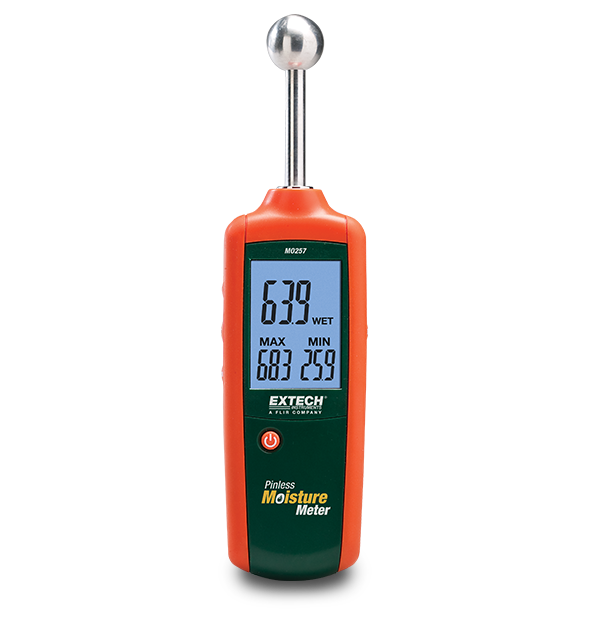Delve Into the World of Moisture Meters: Every Little Thing You Required to Know
In the world of wetness meters lies a world of accuracy and functionality that often goes unnoticed. Recognizing how moisture meters run, the different types offered, and their varied uses can lose light on their importance in making sure quality and effectiveness.
Just How Moisture Meters Work
Moisture meters operate by measuring the electric conductivity or capacitance of products to identify the wetness web content present. These meters are vital devices across various industries, consisting of building, woodworking, and farming. By making use of different methods such as pin-type or pinless innovation, dampness meters give accurate analyses that aid specialists make informed decisions.
Pin-type wetness meters work by placing the sharp pins right into the product being checked. The electric conductivity in between the pins is after that gauged, with greater dampness degrees bring about raised conductivity. Moisture Meter. On the various other hand, pinless dampness meters use electro-magnetic signals to scan a larger location without creating any kind of damages to the product's surface area. These meters are ideal for quickly assessing moisture degrees in huge locations or completed products.
Despite the approach utilized, moisture meters play an important function in avoiding issues such as mold development, architectural damage, or item flaws triggered by excess moisture. Understanding just how these meters work is vital for guaranteeing the quality and honesty of products in various applications.
Kinds Of Moisture Meters
Provided the crucial duty wetness meters play in various sectors, it is necessary to understand the various types readily available to professionals for accurately assessing moisture degrees - Moisture Meter. There are largely two primary types of dampness meters: pinless and pin-type dampness meters

On the various other hand, pinless wetness meters use electro-magnetic sensor plates to check a larger location of the product without triggering any damages. This kind is ideal for rapidly scanning huge areas and is generally utilized for floor covering, walls, and ceilings. Pinless meters are hassle-free for taking readings on finished surface areas without leaving any noticeable marks.
Both sorts of wetness meters have their advantages and are selected based upon the specific needs of the job available. Recognizing the differences between these types is critical for experts to make accurate wetness analyses.
Applications Throughout Industries
Building experts count on moisture meters to examine the moisture levels in structure materials like concrete, timber, and drywall, which is important for maintaining architectural integrity and protecting against problems like rot or mold and mildew. The flooring sector utilizes wetness meters to measure the wetness web content in subfloors before mounting various floor treatments, preventing expensive problems due to excess moisture. In the food market, dampness meters are used to keep an eye on and control moisture levels in items such as grains, nuts, and dried out fruits to maintain freshness and top quality.
Tips for Using Moisture Meters
Use the dampness meter's calibration settings to make have a peek at this website sure exact readings when measuring the wetness content in different products. Calibration is critical for the correct functioning of a moisture meter. Before each use, it is a good idea to examine and readjust the calibration setups according to the specific material being tested. Additionally, see to it the meter is set to the right wetness variety for the product you are determining to acquire one of the most exact outcomes.
When utilizing a pin-type wetness meter, place the pins to the suitable depth advised for the material being evaluated. This guarantees that the moisture analyses are extracted from the right depth within the material, giving an extra precise representation of its moisture material. For pinless wetness meters, remember to keep appropriate contact with the product's surface area to get dependable readings.
Frequently check and change the batteries in your moisture meter to protect against unreliable readings because of reduced power. When not in use to extend its lifespan and preserve its precision, Store the meter in a dry and safe location. By adhering to these suggestions, you can take full advantage of the efficiency of your wetness meter and get precise wetness web content measurements across various materials.
Maintenance and Calibration
To make certain the accuracy of moisture content measurements, regular upkeep and calibration of the moisture meter are vital steps in its appropriate performance. Calibration readjusts the moisture meter to guarantee that it supplies constant and reputable outcomes.
Calibration ought to be carried out regularly, visite site particularly if the moisture meter is utilized regularly or in critical applications where precise measurements are needed. Lots of dampness meters include calibration tools or can be calibrated by expert services. Moisture Meter. It is suggested to maintain a log of calibration days and results to track the efficiency of the wetness meter with time. By adjusting the dampness and maintaining meter on a regular basis, customers can trust the accuracy of the moisture material measurements acquired.
Verdict

To Recommended Reading conclude, wetness meters play a crucial function in numerous sectors by accurately determining the wetness web content of materials. Understanding just how these devices work, the different kinds readily available, and proper maintenance and calibration are necessary for getting dependable outcomes. Whether in construction, production, or farming, using wetness meters assists make sure top quality control and performance in procedures.

In verdict, wetness meters play a vital function in various industries by properly gauging the wetness content of materials.